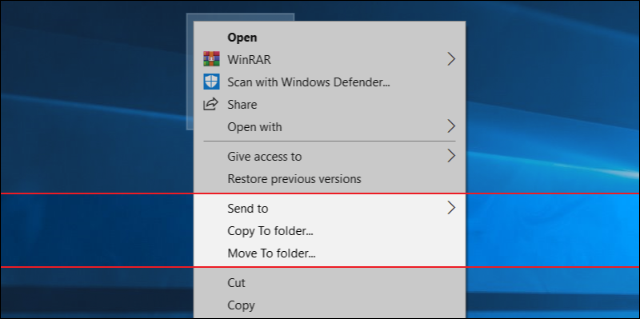How to add Copy To and Move To buttons to the right-click menu

We will provide you with a lot of videos for education and reform. You can ask about any computer malfunction that happened or is happening with you You can donate to this account, even if it is worth at least $ 1, in order to continue giving and collecting information https://www.paypal.me/abdalrahmanaltall

Troubleshoot blue screen errors
A blue screen error (also called a stop error)
can occur if a problem causes your device to shut down or restart unexpectedly.
You might see a blue screen with a message that your device ran into a problem
and needs to restart.
On this page, we’ll
take you through a series of troubleshooting steps to try and help
you figure out the cause of the blue screen error and how to resolve it.
The steps in this
article are intended to help troubleshoot common stop error codes, such as the
following:
·
CRITICAL_PROCESS_DIED
·
SYSTEM_THREAD_EXCEPTION_NOT_HANDLED
·
IRQL_NOT_LESS_OR_EQUAL
·
VIDEO_TDR_TIMEOUT_DETECTED
·
PAGE_FAULT_IN_NONPAGED_AREA
·
SYSTEM_SERVICE_EXCEPTION
·
DPC_WATCHDOG_VIOLATION
Notes
·
You may also receive hexadecimal
error codes, such as 0x0000000A, 0x0000003B, 0x000000EF, 0x00000133,
0x000000D1, 0x1000007E, 0xC000021A, 0x0000007B, 0xC000000F, and more.
·
This article doesn't contain a list of all
error codes, but since many error codes have the same potential resolutions,
your best bet is to follow the steps below to troubleshoot your blue screen
error.
Though the steps on this
page might look complicated at first glance, just follow them in order,
step-by-step, and we’ll try to get you back on track.
Error after an update
was installed
Some blue screen errors
might occur after a specific update is installed on your device. If you
get a blue screen error after an update, try to fix the error by uninstalling
recent updates.
To do this, you'll
need to sign in to Windows using safe mode. Safe mode starts Windows in a
basic state, using a limited set of files and drivers and allows you to perform
troubleshooting steps.
Before you enter safe
mode, you need to enter the Windows Recovery Environment (WinRE). Here’s how:
1. Hold
down the power button for 10 seconds to turn off your device.
2. Press
the power button again to turn on your device.
3. On
the first sign that Windows has started (for example, some devices show the
manufacturer’s logo when restarting) hold down the power button for 10 seconds
to turn off your device.
4. Press
the power button again to turn on your device.
5. When
Windows restarts, hold down the power button for 10 seconds to turn off your
device.
6. Press
the power button again to turn on your device.
7. Allow
your device to fully restart to enter WinRE.
Now that you are in
WinRE, follow these steps to take you to safe mode.
Note
If you’ve encrypted your
device, you’ll need your BitLocker key to start in safe mode.
1. On
the Choose an option screen, select Troubleshoot > Advanced
options > Startup Settings > Restart.
2. After
your device restarts, you'll see a list of options. The preferred option is to
select 5 or press F5 for Safe Mode with
Networking.
1. In
the search box on the taskbar, type control panel, and then
select Control Panel from the list of results.
2. Select Uninstall
a program under Programs. If you’re using Large/Small
icons View, Select Uninstall a program under Programs
and Features.
3. On
the left-hand side, select View installed updates, and then
select Installed On to sort the updates by their installation
date to view the latest updates.
4. Right-click the
update you want to uninstall, and then select Yes to confirm.
Some updates won’t give you the
option to uninstall.
5. Select Restart
Now to completely uninstall the update.
If you need to exit safe
mode, here's how:
1.
Press the Windows logo key + R.
2. In
the Open box, type msconfig, and then
select OK.
3. Select
the Boot tab.
4. Under Boot
options, clear the Safe boot check box.
Comments